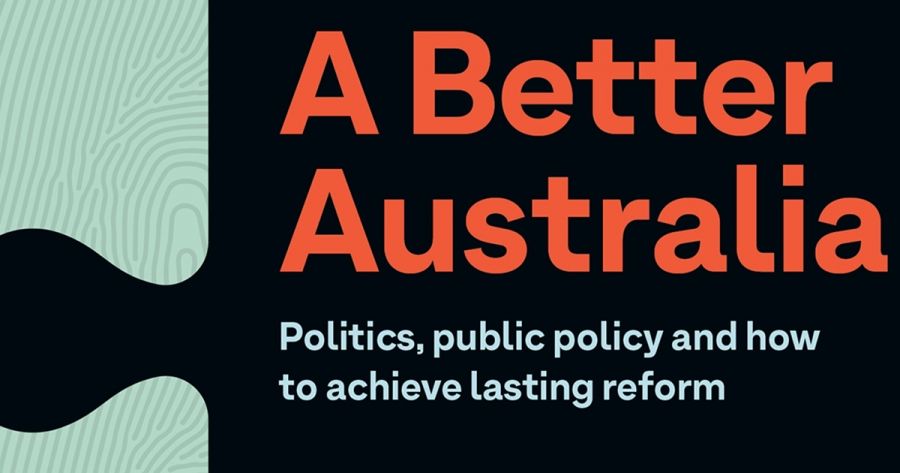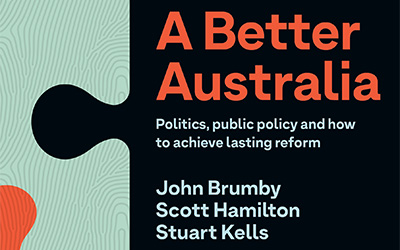
- Free Article: No
- Contents Category: Politics
- Review Article: Yes
- Article Title: Half-open doors
- Article Subtitle: An informative guide to public policy in Australia
- Online Only: No
- Custom Highlight Text:
It is a sign of the times that A Better Australia: Politics, public policy and how to achieve lasting reform begins with a discussion of climate and energy policy. No policy field better illustrates the deficiencies in Australia’s politics over the past generation. It is a tale, as one of the book’s authors, John Brumby, reminds us, of avoidable failure and lost opportunities, as the issue was subjected to the narrower, more immediate incentives offered by partisanship and opportunism.
- Featured Image (400px * 250px):

- Alt Tag (Featured Image): Frank Bongiorno reviews ‘A Better Australia: Politics, public policy and how to achieve lasting reform’ by John Brumby, Scott Hamilton, and Stuart Kells
- Book 1 Title: A Better Australia
- Book 1 Subtitle: Politics, public policy and how to achieve lasting reform
- Book 1 Biblio: Melbourne University Press, $39.99 pb, 320 pp
- Book 1 Cover Small (400 x 600):

- Book 1 Cover (800 x 1200):

- Book 1 Readings Link: https://www.readings.com.au/product/9780522880878/a-better-australia--stuart-kells-scott-hamilton--2024--9780522880878#rac:jokjjzr6ly9m
There were other echoes of Turnbull that worried me, too. As Brumby tells us early in the book: ‘The first thing we need to do is decide what kind of Australia we want. My answer to this question is simple: I want an Australia that is ambitious and not afraid of innovation.’ The slippage between ‘we’ and ‘I’ is telling, and it is far from clear that most Australians are comfortable with ambition and innovation as those terms are understood by Australian political insiders and policy wonks. The result of the 2016 federal election, when Turnbull sought to sell such an agenda to the electorate, was not auspicious.
It would be unfair and ungenerous to sheet home to the three authors of this book Malcolm Turnbull’s sins of omission and commission, but I do see a place for caution. The authors – Brumby, currently chancellor of La Trobe University, Scott Hamilton, a renewable energy expert, and Stuart Kells, a renowned author of books about books as well as finance and business – have produced a valuable compendium of case studies.
The book is less programmatic than the title suggests. The authors do have their ideas about how to make a better Australia, but their effort is most valuable as a meaty set of policy stories. They begin with gun reform, a splendid example of a prime minister and government – John Howard’s, then still in its infancy – seizing the moment to achieve the kind of ‘lasting reform’ to which the book’s subtitle alludes. Today, it is hard to think of any policy area that has become more embedded in Australians’ sense of their difference from Americans. It has become a marker of national identity.
Other chapters take us through disability, marriage equality, drugs, taxation, superannuation, climate and energy, gender, abortion, the environment, Indigenous affairs, and the pandemic. There are the successes, like superannuation; the failures, such as the Voice referendum; and episodes such as Covid-19, where policy could have been better or worse, but at least we didn’t have to endure a Donald Trump or Boris Johnson. The stories are delivered in an engaging, even chatty way by authors who do not mind an anecdote. Mercifully, this is not a book of dry-as-dust political science or policy studies.
Brumby, Hamilton, and Kells like bipartisanship, cooperation, and consensus. They even grapple, albeit briefly, with the way parliamentary chambers are designed and inhabited: wouldn’t it be better if a speaker stood beside the chair and spoke to the whole house in preference to our more adversarial arrangements? How about more free discussion and free votes in Parliament? Well, yes, but every decision of this kind exacts a cost, and a more Burkean approach to representation, with less party discipline, might also limit the ability to hold government to account.
Bipartisanship – usually praised in this book – can also take its pound of flesh. Party agreement, after all, might produce bad policy or, even worse, harsh injustice. Broad bipartisanship between the major parties seems to prevail on treatment of asylum seekers and meagre social security for the unemployed. Bipartisanship ensured that marriage equality occurred in this country years after public opinion was ready for it. Bipartisanship supports negative gearing for property investors and other goodies for the wealthy.
Sometimes, in any event, the best kind of policy requires a government willing to stand up and fight, over years or even decades. We have Medicare today not through bipartisanship but because one party, Labor, backed by the unions, was prepared to fight for it in the face of hostility from the conservative parties and their supporters in the medical profession and health funds. The Coalition, having fought and then dismantled Medibank in the 1970s and early 1980s, then opposed its successor Medicare at every election from 1984 through to 1993. Medicare survives because Labor held firm and won those battles. The Liberals under Howard dropped their opposition at the 1996 election only because they were unwilling to bear more electoral damage over the issue, but they have nonetheless worked hard since, with some success, to undermine key principles and features of the scheme.
It is no doubt better if, in a contentious area of policy where lives will be improved by reform, there is a degree of bipartisanship and consensus. The National Disability Insurance Scheme – explored in A Better Australia – is an example, but there has been enough controversy about issues of implementation, detail, and cost to satisfy the political partisans. It is also at best a doubtful counterfactual to imagine that a greater degree of bipartisanship over the Voice would have pushed it across the line, although I agree with the authors’ suggestion that it was a grave error on Anthony Albanese’s part to adopt implementation of the Uluru Statement virtually as part of his government’s brand.
There is much wisdom in this book – some from the authors, some from the politicians and former politicians they have interviewed (Steve Bracks: ‘You need to build trust when you don’t need it – for the time when you do’). Their account is measured rather than visionary or utopian, but I was sometimes left wondering whether there was really enough oomph here to push strongly enough on partly open doors, which is usually how policy change happens.
I also fear there are few half-open doors right now – at least if the caution of the Albanese government is any indication. The authors rightly emphasise that innovative policy reform in recent decades has often come from the states and territories, and the weight given in their arguments to human capital and innovation is a reminder of the admirable and energetic Victorian Labor governments of the first decade of this century – in which Brumby was so prominent.
But is that going to be enough in this era of populism and authoritarianism, global heating and global hatred? This is an intelligent, informative, and good-hearted book that makes you want to think so, even as hope is clouded by fear and doubt.


Comments powered by CComment